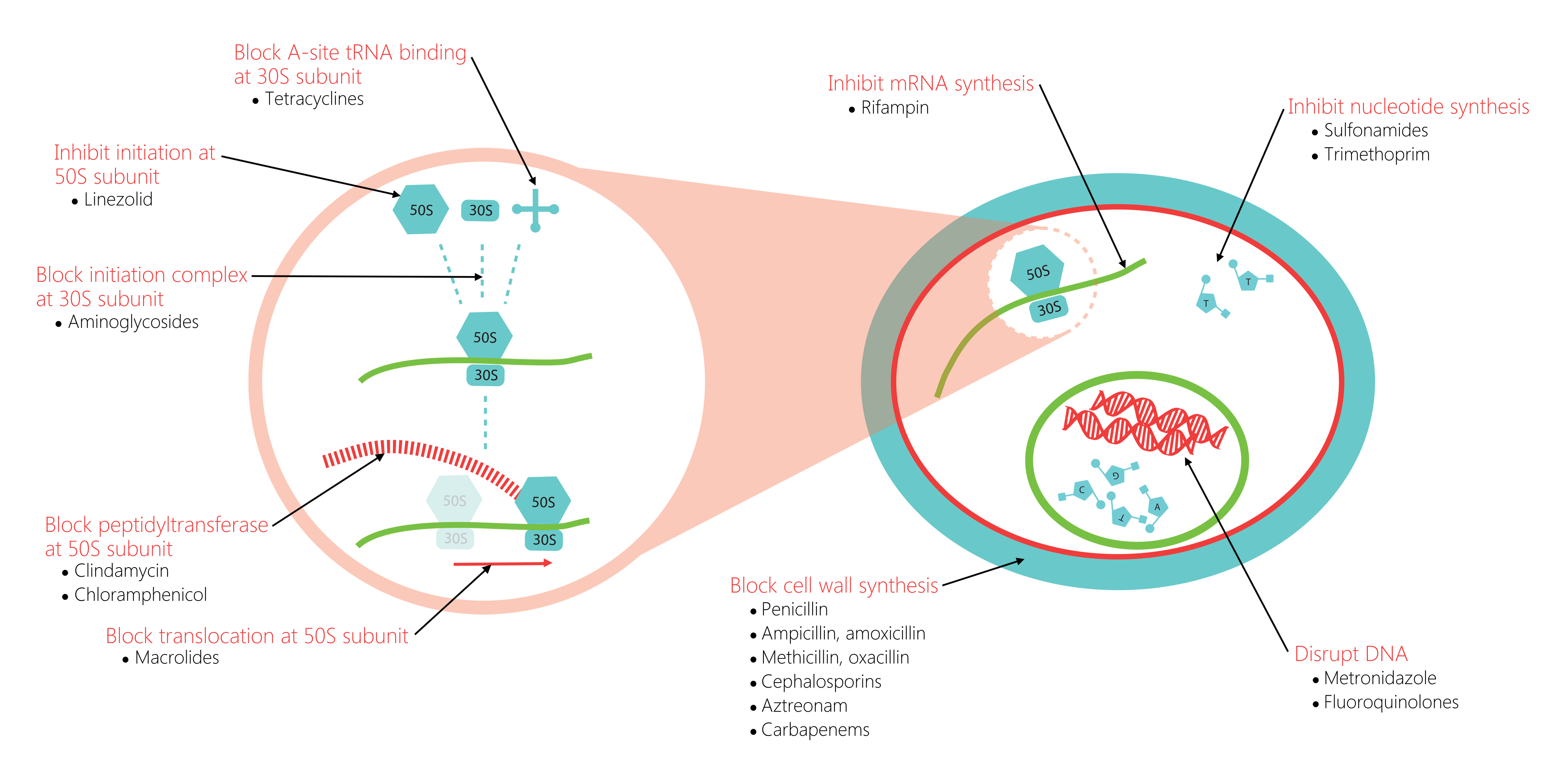WBR0058: Difference between revisions
Jump to navigation
Jump to search
No edit summary |
No edit summary |
||
| Line 31: | Line 31: | ||
IDSA Guidelines: http://cid.oxfordjournals.org/content/43/9/1089.full | IDSA Guidelines: http://cid.oxfordjournals.org/content/43/9/1089.full | ||
[[File:Cell antibiotics.jpg|600px]] | |||
|AnswerA=Erythromycin | |AnswerA=Erythromycin | ||
|AnswerAExp='''Incorrect:''' Erythromycin is a macrolide used to treat atypical pneumonias | |AnswerAExp='''Incorrect:''' Erythromycin is a macrolide used to treat atypical pneumonias | ||
Revision as of 01:34, 24 February 2014
| Author | PageAuthor::William J Gibson |
|---|---|
| Exam Type | ExamType::USMLE Step 1 |
| Main Category | MainCategory::Microbiology |
| Sub Category | SubCategory::General Principles, SubCategory::Infectious Disease |
| Prompt | [[Prompt::A 39-year-old woman presents to her primary care physician complaining of fever, muscle soreness, headache and severe malaise one week after returning from a summer vacation on Cape Cod. Physical exam is significant for a red rash on her leg with an inner ring clearing resembling a bullseye. What is the optimal treatment for this patient?]] |
| Answer A | AnswerA::Erythromycin |
| Answer A Explanation | AnswerAExp::'''Incorrect:''' Erythromycin is a macrolide used to treat atypical pneumonias |
| Answer B | AnswerB::Doxycycline |
| Answer B Explanation | AnswerBExp::'''Correct:''' Doxyclince is a tetracycline used to treat Lyme disease. |
| Answer C | AnswerC::Penicillin |
| Answer C Explanation | AnswerCExp::'''Incorrect:''' Penicillin is a beta-lactam antibiotic used to treat gram-positive organisms and syphillis. |
| Answer D | AnswerD::Trimethoprim-Sulfamethoxazole |
| Answer D Explanation | AnswerDExp::'''Incorrect:''' Trimethoprim-Sulfamethoxazole (Bactrim) inhibits dihyrofolate reductase and is used to treat UTIs |
| Answer E | AnswerE::Ciprofloxacin |
| Answer E Explanation | AnswerEExp::'''Incorrect:''' Ciprofloxacin is a fluoroquinolone which inhibits DNA gyrase and is used to treat gram-negative rods |
| Right Answer | RightAnswer::B |
| Explanation | [[Explanation::The patient in this vignette has the early stages of Lyme disease caused by the spirochete Borrelia burgdorferi. Borrelia Burgdorferi is a zoonotic bacteria that is carried by the Ixodes tick. In its early stages, Lyme disease causes flu-like symptoms and a characteristic “bullseye” rash called erythema chronicum migrans in 80% of patients. Tetracyline antibiotics such as doxycycline are used for Lyme disease and have the advantage that they are effective against human granulocytic anaplasmosis, an infectious disease caused by Anaplasma phagocytophilum that also uses the Ixodes tick as its vector (among others). For later disseminated stages of Lyme disease, a third generation cephalosporin such as ceftriaxone is indicated.
Educational Objective: Early lyme disease is best treated with tetracycline antibiotics. References: First Aid 2014 page 141 IDSA Guidelines: http://cid.oxfordjournals.org/content/43/9/1089.full |
| Approved | Approved::Yes |
| Keyword | WBRKeyword::Microbiology, WBRKeyword::Zoonotic, WBRKeyword::Animal, WBRKeyword::Tick, WBRKeyword::Lyme disease, WBRKeyword::Lyme, WBRKeyword::Bacteria, WBRKeyword::Rash, WBRKeyword::Dermatology, WBRKeyword::Pharmacology, WBRKeyword::Drugs, WBRKeyword::Antibiotics |
| Linked Question | Linked:: |
| Order in Linked Questions | LinkedOrder:: |
